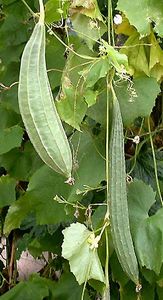
Patola or luffa (scientific name) is commonly planted as vegetable or for food. According to scientists, it contains calcium, iron and plenty of phosphorus.
There are two kinds of patola:
1. One is the many-sided which is inherently ours and the other is the cylindrical type which is called "patolang Kastila."
2. Our local version is the sweeter kind.
Planting
Patola is not difficult to grow, but it likes loose, sandy soil, fertile and does not lodge water. It may be planted at any time of year, but there are more flowers, and fruits are bigger when the weather is cool. Patola is planted two times a year: from March to May and from October to December. But if the fruits will be made into luffa, it is better to plant it in October-December so the harvest falls in summer. Ordinary patola is planted directly in the field; but if it is not in season, plant first in plastic bags (perforated at the bottom) and then latter transfer to the field when it will be needing trellises to climb on.
Land Preparation
1. Plow the field and clean 2-3 times, with 7 days interval.
2. Dig trenches 3 meters apart from each other.
3. Plant the seed in the soil at 3 x 3 (or 2m) meters apart.
4. Set bamboo poles or posts in rows about 3 meters long and 3 meters apart. Tie strings or wire from post to
post about 3 weeks after germination of seeds. Patola will bear fruit even without trellis, but many fruits will turn out in bad shape.
5. Patola needs watering. Dig canal for irrigation about 1½ meters from the plant or between trenches.
Fertilizer - Apply composting animal manure
Harvesting - About 3-4 months after planting, or 45-50 days after flowering, patola can be harvested. A hectare of patola can yield about 10,000 pieces or more, depending on how well the plants have been maintained.
LUFFA

Patola as sponge has long been known in this country, but abroad, they are just beginning to know its use, and have learned to like it. Patola is sewn on a piece of cloth that serves as a handle for rubbing. Because of this, luffa or matured patola is in demand abroad, but we cannot meet this demand. Australian asks for a million pieces, to be sold in drug stores and department stores as sponge, 30x6 cm sizes. This is flat, but expands when put in water. The U.S. gets its supply from Korea (from where luffa is supplied by a certain "Luffa King" because of his extensive luffa plantation for the purpose), by Japan, China and some other countries.
In France, they like luffa as a natural beautifier and cleanser. In Germany, their import of luffa is as natural as DM 1.83 million from Egypt, Greece, Japan, Cuba, USA, Tinisia, France, Netherlands, Italy, Great Britain and Lebanon. Thus, if we can produce enough patola for export, it will mean bringing in dollars to our country, without much competition.
Manner of Preparation
1. Let the patola grow mature before harvesting.
2. Remove the peel and shake off the seeds. It could be easier to clean this by boiling first, but this will diminish the coarseness for rubbing.
3. Dry in the sun for two days (in Summer) or 4-5 days in rainy weather. It can also be dried in the oven but the quality is inferior to that which is sun dried. Its whiteness is less.
4. Wash to clean and soften. Bleach to make it white.
5. Dry in the sun again 3-5 days. Now, the patola becomes wider, softer, and milk colored.
6. Cut into desired sizes (according to customers taste).
7. Seal in plastic bag.
Plant and Planting Materials Directory
source: elgu2.ncc.gov.ph, pictures from www.ruhr-uni-bochum.de, www.acupuncturetoday.com
Related Links:
Agri Business
No comments:
Post a Comment